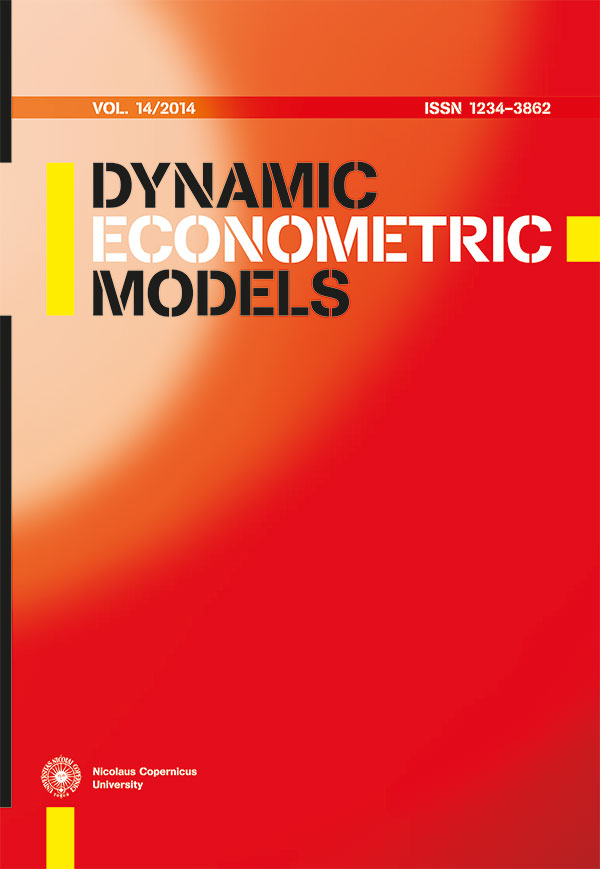“Sell not only in May”. Seasonal Effect on Emerging and Developed Stock Markets
DOI:
https://doi.org/10.12775/DEM.2017.001Keywords
behavioral factors, Halloween indicator, January effect, seasonal anomaly, sell in May.Abstract
Described in Bauman and Jacobsen (2002) stock market anomaly still remains unexplained. In long time series regressions and wide geographical spread research “Halloween effect” is significant on 19 amongst 73 markets, but also in 11 amongst 23 with long time series data. Data shows that abnormal returns could be realized also in strategies staring in October, November and December. We conclude that even with control of weather (sun hours), behavioral (sentiment index, number of IPOs) and macroeconomic (industrial production) factors, the effect persists.References
Andrade, S. C., Chhaochharia, V., Fuerst, M. (2013), "Sell in May and Go Away" Just Won't Go Away, Financial Analysts Journal, 69(4), DOI: https://doi.org/10.2469/faj.v69.n4.4.
Baker, M., Wurgler J. (2007), Investor Sentiment in the Stock Market, Journal of Economic Perspectives, v.21, Spring 2007, 129–157, DOI: https://dx.doi.org/10.1257/jep.21.2.129.
Bouman, S., Jacobsen B. (2002), The Halloween indicator, "Sell in May and go away": Another puzzle, American Economic Review, 92, 1618–1635, DOI: https://dx.doi.org/10.1257/000282802762024683.
Cao, M., Wei, J. (2005), Stock market returns: A note on temperature anomaly, Journal of Banking & Finance, 29, 1559–1573, DOI: https://doi.org/10.1016/j.jbankfin.2004.06.028.
Doeswijk, R. (2008), The Optimism Cycle: Sell in May, Economist (2008), 156, 175–200, DOI: https://doi.org/10.1007/s10645-008-9088-z.
Dzhabarov, C., Ziemba W. (2010), Do Seasonal Anomalies Still Work, The Journal of Portfolio Management, 36 (3), 93–104, DOI: https://doi.org/10.3905/jpm.2010.36.3.093.
Gerlach, J. R. (2007), Macroeconomic news and stock market calendar and weather anomalies, Journal of Financial Research, XXX(2), 283–300, DOI: https://doi.org/10.1111/j.1475-6803.2007.00214.x.
Gugten, T. v. d. (2010), Stock market calendar anomalies and macroeconomic news announcements, Working Paper, Erasmus University Rot-terdam, http://hdl.handle.net/2105/7758.
Gultekin, M. N., Gultekin, N. B. (1983), Stock Market Seasonality: International Evidence, Journal of Financial Economics, 12, 469–481, DOI: https://doi.org/10.1016/0304-405X(83)90044-2.
Haggard, K. S., Witte, H. D. (2010), The Halloween effect: Trick or treat? International Review of Financial Analysis, 19(5), 379–387, DOI: https://doi.org/10.1016/j.irfa.2010.10.001.
Hirshleifer, D., Shumway T. (2003), Good Day Sunshine: Stock Returns and the Weather, The Journal of Finance, 58(3), 1009–1032 http://www.jstor.org/stable/3094570
Hong, H., Yu, J. (2009), Gone fishin’: Seasonality in trading activity and asset prices, Journal of Financial Markets, 12(4), 672–702, DOI: https://doi.org/10.1016/j.finmar.2009.06.001.
Huber, P. (1973), Robust Regression: Asymptotics, Conjectures and Monte Carlo, The Annals of Statistics, 1(5), 799–821. http://www.jstor.org/stable/2958283.
Jacobsen, B., Mamun, A., Visaltanachoti, N. (2005), Seasonal, Size and Value Anomalies, DOI: http://dx.doi.org/10.2139/ssrn.784186.
Jacobsen, B., Marquering, W. (2008), Is it the weather? Journal of Banking & Finance, 32, 526–540, DOI: https://doi.org/10.1016/j.jbankfin.2007.08.004.
Jacobsen, B., Marquering, W. (2009), Is it the weather? Response, Journal of Banking & Finance, 33, 583–587, DOI: https://doi.org/10.1016/j.jbankfin.2008.09.011.
Jacobsen, B., Visaltanachoti, N. (2009), The Halloween Effect in US Sectors, Financial Review, 44(3), 437–459, DOI: https://doi.org/10.1111/j.1540-6288.2009.00224.x.
Jacobsen, B., Zhang C.Y. (2012a), The Halloween Indicator Everywhere and All the Time, http://ssrn.com/abstract=2154873.
Jacobsen, B., Zhang, C.Y. (2012), Are monthly seasonals real? A three century perspective, Review of Finance, 17(5), 1743–1785, DOI: https://doi.org/10.1093/rof/rfs035.
Kamstra, M. J., Kramer, L. A., Levi, M. (2003), Winter Blues: A SAD Stock Market Cycle, American Economic Review, 93(1), 324–343, DOI: https://doi.org/10.1257/000282803321455322.
Kaustia, M., Rantapuska, E. (2016), Does mood affect trading behavior? Journal of Financial Markets, 29, 1–26, DOI: https://doi.org/10.1016/j.finmar.2015.08.001.
Keef, S. P., Khaled, M. S. (2011), A review of the seasonal affective disorder hypothesis, Journal of Socio-Economics, 40, 959–967, DOI: https://doi.org/10.1016/j.socec.2011.08.012.
Kelly, P. J., Meschke, F. (2010), Sentiment and stock returns: The SAD anomaly revisited, Journal of Banking & Finance, 34(6), 1308–1326, DOI: https://doi.org/10.1016/j.jbankfin.2009.11.027.
Lean, H. H. (2011), The Halloween puzzle in selected Asian stock markets, International Journal of Economics and Management, 5(2), 216–225, http://www.scopus.com/inward/record.url?eid=2-s2.0-84869413435&partnerID=MN8TOARS.
Lucey, B. M, Zhao, S. (2007), Halloween or January? Yet another puzzle, International Review of Financial Analysis, 17, 1055–1069, DOI: https://doi.org/10.1016/j.irfa.2006.03.003.
Maberly, E. D., Pierce, R. P. (2004), Stock market efficiency withstands another challenge: Solving the "sell in May/ buy after Halloween" puzzle, Econ Journal Watch, 1, 29–46, https://econjwatch.org/158.
O'Higgins M., Downes, J. (1990), Beating the Dow. A high-return-low-risk method for investing in industrial stocks with as little as $5000, Harper Collins, New York
Saunders Jr., E.M., (1993), Stock Prices and Wall Street Weather, The American Economic Review, 83(5), 1337–1345, http://www.jstor.org/stable/2117565.
Qiu L., Welch I. (2006), Investor Sentiment Measures, http://dx.doi.org/10.2139/ssrn.589641.
Zarour, B. A. (2007), The Halloween effect anomaly: Evidence from some Arab countries equity markets. Studies in Business and Economics, 13(1), 68–76, http://hdl.handle.net/10576/6858.
Downloads
Published
How to Cite
Issue
Section
License
The journal provides an Open Access to its content based on the non-exclusive licence Creative Commons (CC BY-ND 4.0).
To enable the publisher to disseminate the author's work to the fullest extent, the author must agrees to the terms and conditions of the License Agreement with Nicolaus Copernicus University.
Stats
Number of views and downloads: 753
Number of citations: 0



